
OverviewHitless protecTIon describes the ability to switch between the primary and backup line card without losing framing synchronization when a primary line-card failure occurs. This feature ensures that telecommunications equipment will provide uninterrupted or continuous service and maintain an extremely high-reliability rating.
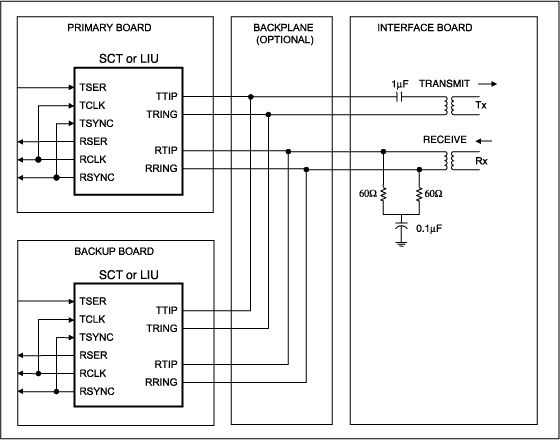
Figure 1. An example of typical connections for a system that provides hitless protection and eliminates the need for bulky mechanical relays.
One-to-one (1 + 1) redundancy refers to a configuration where each line card has a dedicated backup card waiting in case of failure. N + 1 redundancy describes a configuration in which multiple cards have only one backup card to share among them. These traditional protection designs often required the use of relay modules to switch the signal between the primary and the backup line card.
There are three notable disadvantages to using relays. Firstly, relay switching times are slow, which causes data corruption on the line. This data corruption results in bit errors, data loss, and perhaps a loss-of-frame condition. A loss-of-frame condition exacerbates the problem because it takes a considerable amount of time to reframe, during which all data is misaligned and, therefore, garbage. Secondly, the relay modules are bulky and occupy valuable board space. Finally, the relay modules require a considerable amount of power when used on boards with multiple T1/E1 lines.
Figure 1 shows a redundant scheme that supports hitless protection. The backup transceiver is receiving and framing in parallel with the primary transceiver. This is possible because the Dallas Semiconductor line interface units are designed with high-impedance receive inputs and transmitter outputs that can be tri-stated. Therefore, the backup line card inputs and outputs do not affect the signal that the primary line card is transmitting and receiving. This type of configuration eliminates the need for bulky mechanical relays.
Microprocessor-Controlled SwitchingTo switch from the primary LIU card to the backup card, the following steps need to be performed:
- Disable the transmit current limiter of the primary LIU and the backup LIU.
- Enable the backup transmitter while the primary transmitter is still operating.
- Disable the primary transmitter by tri-stating its output drivers.
- Enable the transmit current limiter of the primary LIU and the backup LIU.
Table 1. Register Settings for the DS2155 Single-Chip Transceiver
Table 2. Register Settings for the DS21352 and DS21552 Single-Chip Transceivers
Note: The TEST2 register may also be referred to as LITEST2 in some DS21352/DS21552 documentation.
Table 3. Register Settings for the DS21354, and DS21554 Single-Chip Transceivers
Note: The TEST3 register may also be referred to as LITEST2 in some DS21354/DS21554 documentation.
Table 4. Register Settings for the DS21(Q)348 and DS21(Q)48 Line Interface Units
Older generation devices (i.e., the DS21352, DS21552, DS21354, DS21554, DS21(Q)348, and DS21(Q)48) will power-up with the transmitter drivers turned on. To prevent this condition from occurring, the user must implement the following in the system:
- Initialize the device by writing 0x00 to the entire register addresses range.
- Disable the transmitter of the device using the register bits mentioned in Tables 1, 2, 3, and 4.
- Set the TEST pin state low to enable regular device operation.
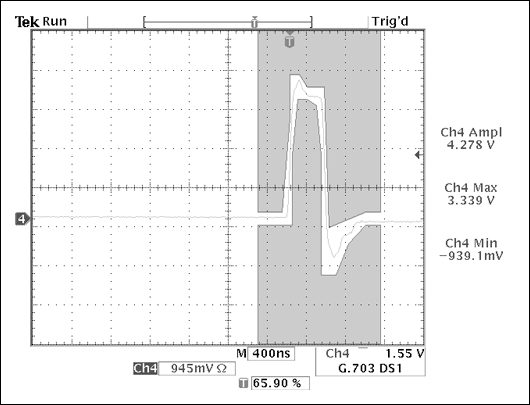
Figure 2. T1 pulse shape for port 1.
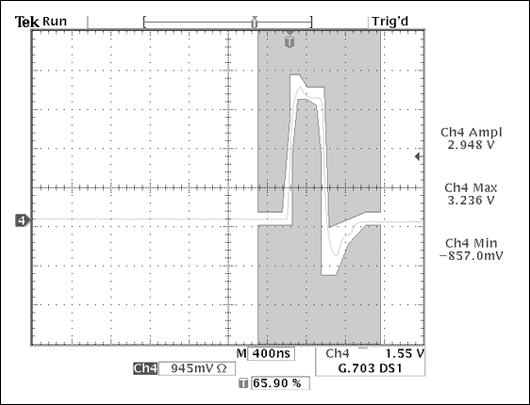
Figure 3. T1 pulse shape for port 2.
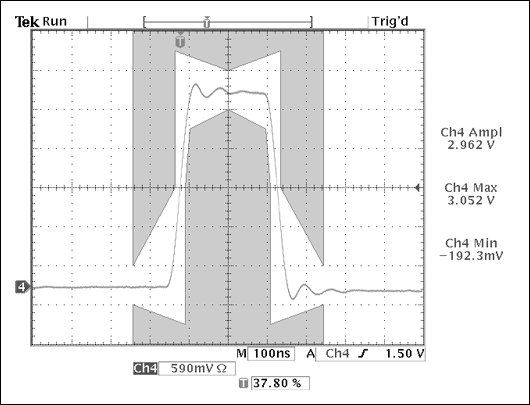
Figure 4. E1 pulse shape port 1.
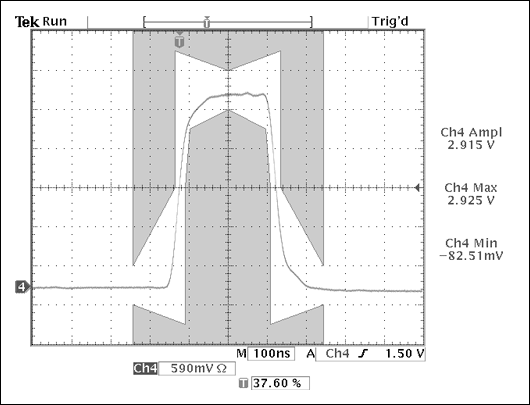
Figure 5. E1 pulse shape port 2.
Test SetupThe test setup in Figure 6 was used to generate the pulse template scope shots in Figures 2 though 5. The setup consisted of a modified DS21Q55 demonstration kit, an Acterna T1 Fireberd, an Acterna E1 Fireberd, and a Tektronix® TDS 3054 with pulse mask option and differential signal adapter. The DS21Q55 was used instead of two DS2155 devices because the DS21Q55 board was readily available and switching between the primary and backup device could be done in software using the DS21Q55 demonstration kit. Since the DS21Q55 is actually four DS2155 devices placed on a single board, the DS21Q55 results should not differ from those that would be obtained using two DS2155 devices. The board was modified so that the DS21Q55's ports 1 and 2 shared the same network interface circuit on the two transmit ports and two receive ports. To simulate the longer than normal tip and ring-signal routes that would be present in a real-world system, 60 inches of twisted pair cable were used between the transformer and the tip and ring signals on the DS21Q55. The extra distance did not degrade the performance of the DS21Q55 transmitter or receiver in any way.
Figure 6. Hitless-protection switching test setup.
Tektronix is a registered trademark of Tektronix, Inc.
欢迎分享,转载请注明来源:内存溢出

 微信扫一扫
微信扫一扫
 支付宝扫一扫
支付宝扫一扫
评论列表(0条)